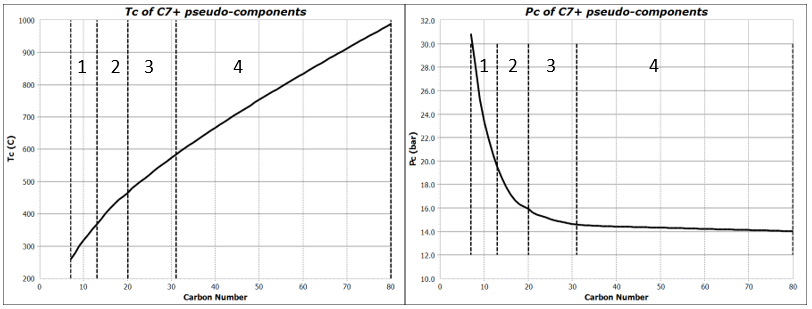Reservoir fluid characterization is no longer limited to the classical steps of splitting the plus fraction into carbon number fractions, lumping of C7+ fractions, and assignment of EoS model parameters to the pseudo-components. An EoS model must be applicable not only in reservoir engineering calculations, but also in flow assurance and process calculations.
Produced reservoir fluids often carry water. While water is usually considered an inert phase in reservoir simulation studies, the mutual solubility of water and hydrocarbons cannot be ignored in flow assurance and process calculations. Hydrates may form when a well stream carrying water is transported in a pipeline, and a hydrate inhibitor (glycol or methanol) may have to be added. To quantify the loss of hydrate inhibitors to the hydrocarbon phases, a thermodynamic model is required that can handle mixtures of hydrocarbons and aqueous components. Simulation of CO2 storage in aquifers requires a model that correctly predicts the CO2 solubility in water and brine as well as the water solubility in CO2.
The parameters of a classical cubic equation (SRK or PR) can be chosen to simulate that a water phase is practically immiscible with gas and oil phases, but a classical cubic equation is insufficient to provide a correct representation of the mutual solubility of water and hydrocarbon phases.
When developing an EoS model for a water free reservoir fluid in PVTsim, the fluid is behind the scene prepared for subsequent simulations of the fluid mixed with formation water. This has the advantage that an EoS model developed for use in reservoir studies can also be used in flow assurance and process simulation studies. All the user has to do is to select either HV or CPA as the Polar Comps model from a dropdown menu before adding any aqueous components.

HV stands for Huron-Vidal and uses a so-called Non-Random-Two-Liquids theory to account for the fact that polar components like water prefer to be surrounded by other polar compounds. This conflicts with the premise of the classical mixing rules that the molecules in a phase must be randomly distributed.
CPA stands for Cubic Plus Association and uses a different concept. It accounts for the tendency by polar compounds to associate, i.e. stick together. This tendency is what gives water a high boiling point and a high critical temperature as compared to other substances of approximately the same molecular weight. Water molecules can associate not only with other water molecules, but also with other polar components as for example methanol.
No matter whether HV or CPA is selected, all component pairs except those with H2O, hydrate inhibitors and salts are still handled using the classical EoS. Simulation results for a mixture with aqueous components are therefore fully consistent with the results obtained with a classical cubic EoS for the water free system.
The HV and CPA model parameters are stored in the PVTsim Nova pure component database. If water or a hydrate inhibitor is added to a water free fluid, which could be one previously used in reservoir simulation studies, the relevant HV or CPA parameters are automatically applied.
To assist PVTsim Nova users select the optimum Polar Comps model for a particular purpose, validation reports are available for download from Calsep’s website showing how HV and CPA simulation results compare with experimental data.
EXAMPLE OF USING AN EXISTING EOS MODEL IN FLOW ASSURANCE AND PROCESS CALCULATIONS
An EoS model exists for a gas condensate fluid. Experimental and simulated Constant Volume Depletion (CVD) data is shown in the below figure.

The reservoir fluid is saturated with water at reservoir conditions (495 bar and 143 oC).
Initial flow assurance and process evaluations are to be performed to reveal whether
- Gas hydrate formation will take place at pipeline conditions of 250 bar and 15 oC
- If so, what volume% will the gas hydrates take up of the total pipeline volume?
- How much water will be produced at standard conditions per 1000 kg total feed if the well stream is processed through a 2-stage separator train (1st stage: 75 bar, 81 oC, 2nd stage: 47 bar 44 oC)?
Had it been necessary to develop a new EoS model, it could have taken long to answer these questions. With access to an existing EoS model for the water free gas condensate, the questions can be answered in a few minute by following the below calculation steps in PVTsim.
1. Select the water free fluid composition characterized for the developed EoS model.
2. Select the appropriate Polar Comps model (HV or CPA).
3. Saturate the fluid with water at reservoir conditions.

4. Make a phase envelope calculation to ensure the water line passes the reservoir P & T.

5. Generate a Hydrate PT curve. It shows that hydrates will form at pipeline conditions (black spot).

6. Make a Hydrate PT flash calculation at pipeline conditions. It shows that the volume% of hydrates is 0.56%.

7. Open the Unit Operation menu, choose 3-Phase Separators and input

The output shows that 6.77 kg water will be produced at standard conditions per 1000 kg feed.




